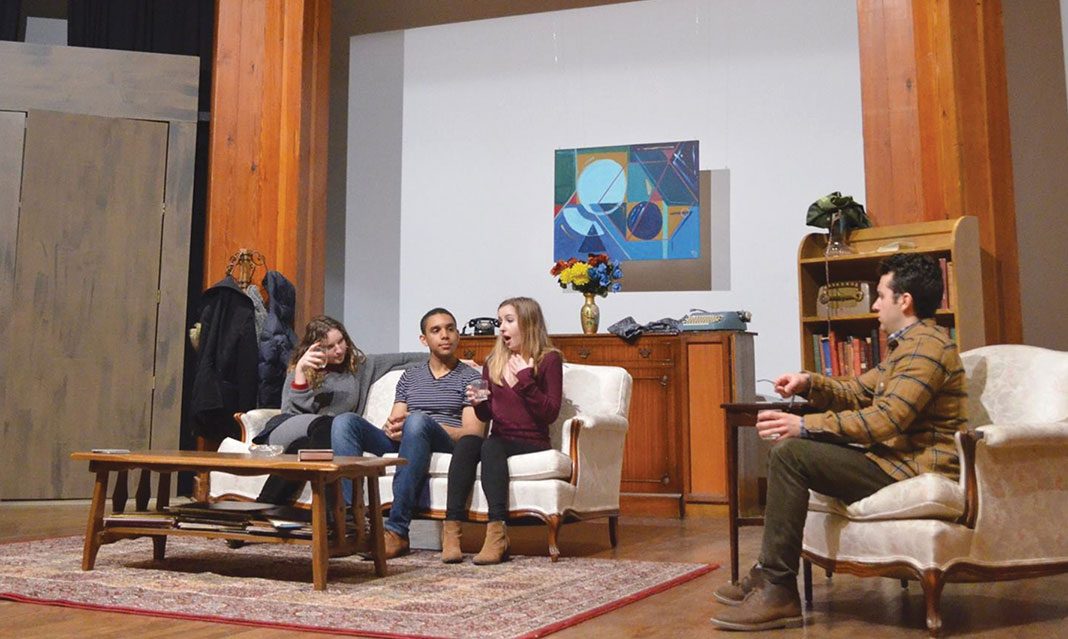The Trinity College Dramatic Society premiered Who’s Afraid of Virginia Woolf? last Thursday. Written by Edward Albee in 1962, the play is an absurd, dark comedy that consists of three acts. The production explores the way human beings rely on illusions to cope with tragedy. Director Lauren Ishak writes, “[The play is] wonderfully entertaining, devastating, and hilarious all at once.”
Who’s Afraid of Virginia Woolf? is about shattering illusions and stripping the comfort—or perhaps burden—of deception from humanity. This is evident in an exchange between characters George (Matthew Fonte) and Martha (Joanna Decc): “Truth or illusion, George; you don’t know the difference,” Martha says, to which George responds, “No, but we must carry on as though we did.”
The play examines this thin line between reality and illusion. It poses philosophical and existential questions pertaining to the nature of identity and relationships, as well as notions of meaning, time passage, and purpose. How can we ever be certain of reality? How can we find meaning in the midst of absurdity? And how do we fill emotional voids within us?
On the surface, the play seems to be about a couple, Martha and George, whose marriage is falling apart. Meanwhile, more profound feelings arise between the pair. The play exemplifies awkward social gatherings. Martha, George, and their guests, Nick (Aaron Hale) and Honey (Eiléanór O’Halloran), rely on alcohol to cope. The two couples are always drunk and continuously attempt to humiliate and attack each other, both verbally and physically.
When Nick accuses everyone of being crazy, Martha responds, “‘tis the refuge we take when the unreality of the world weighs too heavy on our tiny heads.’” Martha acknowledges a need for escape and refuge, which also seems to be the nature of her relationship with George. It’s difficult to tell whether their relationship is functional or dysfunctional. On the one hand, it is obviously dysfunctional—hence, the alcohol and abuse. However, their “dysfunctionality” seems to be in sync; they live in a world of their own making, governed by their own rules. They rely on each other to bring out the best (or worst) in one another. Ultimately, they live in agreement.
As a dark comedy, Who’s Afraid of Virginia Woolf? is dominated by humour. The cast brilliantly conveyed both the darkness and humour of the play. The performance left the audience stunned at times, and laughing at others. The play is hilarious, until we realize that it’s not. It moves from Act 1, “Fun and Games,” to Act 3, “The Exorcism,” illustrating the unfolding of dark truths. The play becomes claustrophobic at times, making the audience feel stuck; we almost want to reach out to the characters and beg them to stop, or to nervously sneak out of the room.
The setting of the play was a cozy living room, with a bookshelf in one corner, a typewriter, a CD player, and a liquor stand. The cozy set, however, contrasts the reality of the hostile environment. Perhaps this juxtaposition is a reflection of the most prominent theme of the play: illusion versus reality.
The play’s title is like the punch line of an intellectual joke that the audience never heard. The characters repeatedly sing, “Who’s afraid of Virginia Woolf,” mostly at times when they want to diffuse anger or avoid some element of reality. It’s fitting that the joke is never given to the audience, as it resembles the notion that life is entirely unknowable and ridiculous.
Virginia Woolf is known for both her challenging writing style and her ability to write with raw emotion to depict the painful tragedy of mundane life. When the characters sing, “Who’s afraid of Virginia Woolf,” they sing in the melody of the Disney tune, “Who’s Afraid of the Big Bad Wolf?” Woolf’s name replaces “the big bad wolf.” Woolf is an appropriate replacement because she fits with the play’s academic environment (Nick and George are both professors).
In an important scene, Honey peels the labels off brandy bottles. George remarks, “We all peel labels […] when you get through the skin, all three layers […] when you get down to the bone, you haven’t got all the way, yet. There’s something inside the bone… the marrow.” This scene encompasses the play’s meaning. Who’s Afraid of Virginia Woolf? is about peeling labels; it’s about getting to the marrow of life and stripping away comfort.
In the final scene, the most poignant scene in the play, when George sings, “Who’s afraid of Virginia Woolf,” Martha says quietly, “I am George… I am.” Perhaps we are all afraid of the bare truth, and the reality that strips our souls in the midst of tragedy.
Who’s Afraid of Virginia Woolf? ran until January 21 at the George Ignatieff Theatre.



